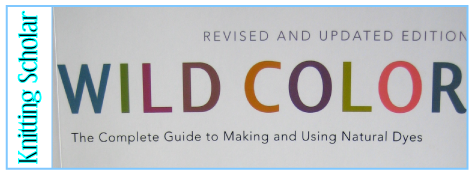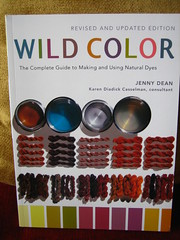First, the facts:
Title: Wild Color: The Complete Guide to Making and Using Natural Dyes. (Revised and Updated Edition)
Author: Jenny Dean
Published by: Watson-Guptill, 1999, 2010
Pages: 144
Type: Dyeing.
Chapters:
1. Dyeing Techniques
2. The Dye Plants
The In-Depth Look:
From the Preface: “The revised edition of Wild Color brings the craft of natural dyeing into the 21st century and is the result of over three decades of experience with natural dyes. … Today, when concern for the environment and conservation of the resources of the natural world are of paramount importance, it is vital that we look towards the future and consider their environmental and human impact of our activities.”
This is an update of the 1999 edition of this very detailed, very thorough book on natural dyeing.
I don’t have a copy of the original, so I can’t tell you exactly how or why this is different, but what I can tell you is that this is a very detailed, very thorough exhaustive overview of the dyeing process. Starting with a history of dyes, and moving into the techniques, it explores everything you could ever want to know. Or so I assume.
The book goes into great detail about how to prepare your leaves, roots, barks, and petals for dyeing. What kind of water to use (and how your water’s pH balance affects the process). Whether to use mordants, and which ones. The differences in dyeing animal fibers and vegetable fibers. The effects of color modifiers … all of this is explained in depth.
Then she gets to specific plants. She provides a photo of what they look like, where to find them, and color swatches for the colors you can expect from them, depending on the process you choose. The photos are lovely to look at, and the swatches clear–they’re of the “paint chip” variety, not photos of actual, dyed yarn.
This section is sorted alphabetically by the Latin name for each dye, and it took me a while to figure that out. Each page lists the Latin name in small type at the top, and then the common name (Hollyhock, Madder, etc.) after, in a larger typeface, so that it’s the familiar name that catches your eye. It took me a couple passes to realize that the book wasn’t sorted by color themes or by the easily-read names at the top of the page, but the smaller, easy-to-ignore Latin names. I wonder why they went this way, or at least why they then kept the Latin so small, but … that’s what Indexes are for, and this has a good one.
Ultimately, this is a beautiful book. If you’re at all interested in dyeing–especially with natural sources rather than bottles of store-bought stuff that is harsher for the environment–you owe it to yourself to take a look.
This book is available at  Amazon.com.
Amazon.com.
Want to see bigger pictures? Click here.

This review copy was kindly donated by Watson-Guptill. Thank you!

